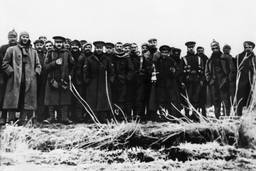Fighting the Larger War
The War On Terror is unique because its political, temporal and geographic borders are unknown and its enemy is fluidly ill-defined.
Neve Gordon
While the fighting in Lebanon was still raging, many analysts claimed that Hezbollah’s modern weaponry and use of civilian spaces for military purposes distinguished the war from any other.
“Never before in history has a terrorist organization had such state-of-the-art military equipment, ” an Israeli general was quoted as saying in the New York Times. And yet, “Hezbollah has no armor or easily visible storehouses or logistic lines,” the Times continued, “and its members live among the civilian population of southern Lebanon, storing their weaponry in civilian buildings.”
Article after article mentioned the homes used as repositories for missiles, how the missiles were launched from village centers, and the way Hezbollah guerrillas, after firing the missiles, immediately blended back into the civilian population.
What struck me about these descriptions was that there was really nothing new about them; in fact, most guerilla warfare has been carried out in a similar manner. Even the pre-state Jewish paramilitary groups that attempted to drive the Brits out of Mandatory Palestine operated in comparable ways.
In other words, what the newspapers described as a new phenomenon was actually old, and what in reality was truly new was totally elided. The Lebanon war was, in effect, a war within a war, and the other war – the war within which it took place and which continues to wreak havoc – is unique.
Senior military planners at the Pentagon readily accepted the war-within-a-war thesis. According to the New York Times, they cast the conflict “as a localized example of America’s broader campaign against global terrorism,” but noted that “any faltering by Israel could harm the American efforts in Iraq and Afghanistan.”
But what, one might ask, is so unique about the war on terrorism?
In May 2004, Paul Hoffman, the Chair of the International Executive Committee of Amnesty International, prepared a paper for UNESCO’s World Forum on Human Rights, in which he eloquently explains this new war’s distinctive characteristics. Shortly before the conference, Hoffman was informed that he would not be delivering the keynote address as had originally been planned, and that his remarks would not be distributed or published because they displeased the United States delegation.
It is unclear which part of Hoffman’s academic paper the Bush administration considered so threatening, but one passage did stand out as quite frightening. In it, Hoffman underscores that “the war on terrorism exists in a parallel legal universe in which compliance with legal norms is a matter of executive grace. … The concept of ‘terrorism’ put forward is any act perceived as a threat by those waging the war against it. The battlefield is the entire planet, regardless of borders and sovereignty. The war on terrorism might continue in perpetuity, and it is unclear who is authorized to declare it over. Human rights protections,” he concludes, “simply do not exist when they conflict with the imperatives of the war on terrorism.”
Although Hoffman goes on to discuss the “human rights free zones” engendered by this war, places like Abu Ghraib, these features are by no means unique. Rather, the war on terrorism is historically distinctive, as Hoffman himself suggests, because its political, temporal, and geographic borders are unbound and unknown, and it is fought against an enemy whose identity is ill-defined and therefore fluid. This is not a minor issue, and it should be remembered when analyzing the different wars being waged these days, not least the one that just took place in Lebanon.
While Israel is certainly responsible for crimes perpetrated in Lebanon, the anti-war movement should really direct most of its energies towards replacing the leadership of the two countries that started the global war on terrorism – the United States and Britain – and concentrate less on the countries carrying out the proxy wars.
After all, it was not due to Israel’s warmongering, Hezbollah’s violent provocations or even al-Qaeda’s horrific attacks that the human species sharing this planet have passed a threshold where there is no horizon beyond war. It was President Bush and his friend on 10 Downing Street who have produced this apocalyptic reality and it is against them that our rage must be channeled. We must challenge and deride them through our letters and articles, drawings and paintings. We must voice our dissent at protests and strikes. We must do all this and more until they, as well as their friends and supporters, are forced out of office.

I hope you found this article important. Before you leave, I want to ask you to consider supporting our work with a donation. In These Times needs readers like you to help sustain our mission. We don’t depend on—or want—corporate advertising or deep-pocketed billionaires to fund our journalism. We’re supported by you, the reader, so we can focus on covering the issues that matter most to the progressive movement without fear or compromise.
Our work isn’t hidden behind a paywall because of people like you who support our journalism. We want to keep it that way. If you value the work we do and the movements we cover, please consider donating to In These Times.





